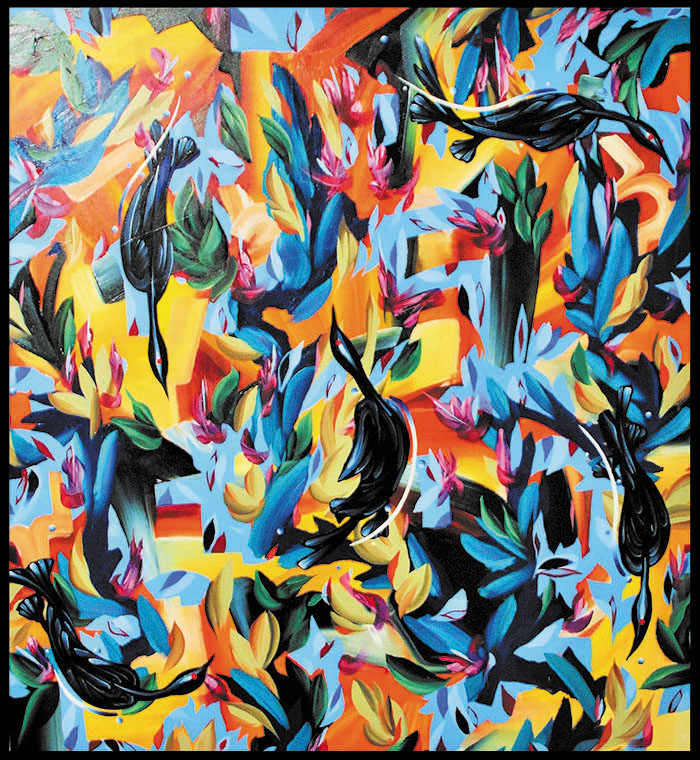
“As a new resident to the Seattle area I was searching for new ideas and inspirations for a painting. My work usually conveys movement and colors of various subject matter joining together to create a dynamic force. I knew I wanted to find something that is of Washington and the Seattle area. Using nature oriented objects and forms in most of my works I wanted to apply the same for what this new piece would be. I went running one afternoon around Green Lake in Seattle and was watching the diving birds that disappear and reappear while in search for food. Diving under the surface and into the depths of the water. I imagined the landscape below the surface with shadowy silhouettes of the diving birds, crossing over one another layered by the lakes aquatic plants. After imagining this scene and seeing these birds once again on Lake Union I decided I would paint this image out as my first paining living here in Seattle. Using oil paints, my preferred medium in the studio, this painting conveys a feeling of light coming through the surface as the water moves above, the birds joined in movement as they swim underneath the surface in search for food. Abstracted plants and forms convey a swift dance taking place below unseen by the passerby above.”
By Micheal Rios, Tulalip News
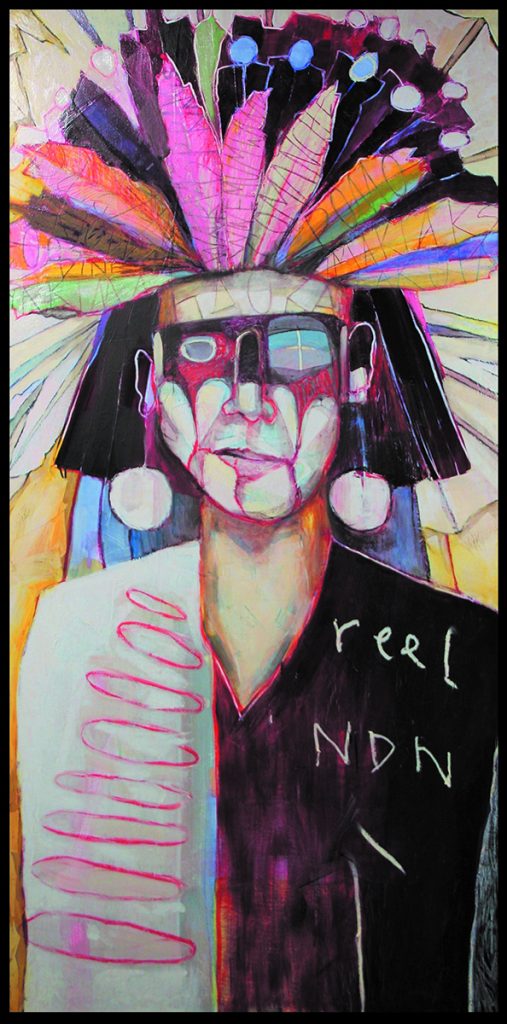
“This image emerged through processing the authenticity of what contemporary American Indian looks like and how it is perceived by Native and non-Native viewers. The painting HÉYÓKA tackles Indigenous identity through invoking multiple variables such as skin color, hair length (a visual quotation from the Boarding School eras), gender roles, authentic regalia, and speaking tribal languages. As the artist, I am taking a look at how post-assimilation policies have affected our collective Indigenous identities, primarily through understanding how pan-Indian tropes have played an important role in rebuilding Native Pride in the recent past. However, to continue on a true path of decolonization and re-Indigenization we need to begin the dire acts of reclaiming our specific Tribal cultures and memories (names of tribes in the headdress).
This portrait utilizes a conceptual irony by quoting the ‘Hollywood Injun’ through the text reel NDN, evoking a hybrid character, perhaps half-Tonto / half-Lone Ranger. However, the smirk on the characters scarred face, reveals a tension that is both of humor and confidence. Perhaps asking the viewer to take a look at their own preconceived content that is brought to this image. Are the blue circles in the headdress feathers, or corporate suits? Is this stereotype or contemporary Indigenous warrior? Can authentic forms of visual decolonization and indigenization occur through painting? HÉYÓKA is trickster, the sacred opposite whose empowerment comes by reflecting taboos within the culture. Through putting the mirror back onto the viewer (a negation of ‘eyes’ in the figure) this HÉYÓKA is now the one asking the questions.”
In the ancestral language of this land, Lushootseed, the phrase sgʷi gʷi ?altxʷ means House of Welcome. More than just a name, the Longhouse Education and Cultural Center at Evergreen State College in Olympia being officially dubbed sgʷi gʷi ?altxʷ gives credence to a reciprocal relationship that is both open hearted and open minded.
Created in 1995 as a public service center, the Longhouse’s mission is to promote Indigenous arts and cultures through education, cultural preservation, creative expression, and economic development.
In the beginning, the cultural center’s focus was on six local Puget Sound tribes and their ever-evolving artists. Today, the Longhouse collaborates with highly talented Indigenous artists throughout the Pacific Northwest region, across the nation, and distant lands spanning the globe. Through residency programs with master artists, culture bearers are inspired to develop their abilities while expanding their imaginative capacities in pursuit of creating entirely new boundaries for what defines ‘traditional’ and ‘contemporary’ designs.
“Art allows us to sing without a song, to give our true spirit into something we create out of something nature has given us,” explained Master artist Bruce Subiyay Miller (Skokomish). “Our people create with the natural elements of wood, plant fibers or native plants. Through these acts of creation, our culture continues to live today. That is important at a time when many of us have lost our languages, our customs, and many of the things we look upon as comprising a complete culture.
“We still have our artwork!” he added. “Through that, all the ancestors that lived on this Earth from the beginning of time in our tribal lineages, still exist as long as we have the art. That is what art means to me.”
To celebrate the House of Welcome’s 25 years of groundbreaking work we examine an art exhibition that truly captures the essence of what it means to facilitate cross cultural exchange. Building Upon the Past, Visioning Into the Future showcases cultural concepts and next level skillfulness from over 70 Indigenous artists with whom the Longhouse has built relationship, from the early days, right up to the present. Many of the featured artists have received a grant, taught a workshop, exhibited work, been an artist-in-residence, or otherwise participated in Longhouse programming.
Curated by Longhouse staff members Erin Genia (Sisseton-Wahpeton Oyate) and Linly Logan (Seneca), this one-of-a-kind exhibition features beautiful artistry from tribal members that call this land home. Local tribal representation include Squaxin Island, Skokomish, Puyallup and many other Coast Salish tribes. Tribes from across the nation are also represented, from Alaska to the Great Plains, and across the Pacific Rim, including Native Hawaiians and Maori artists from New Zealand.
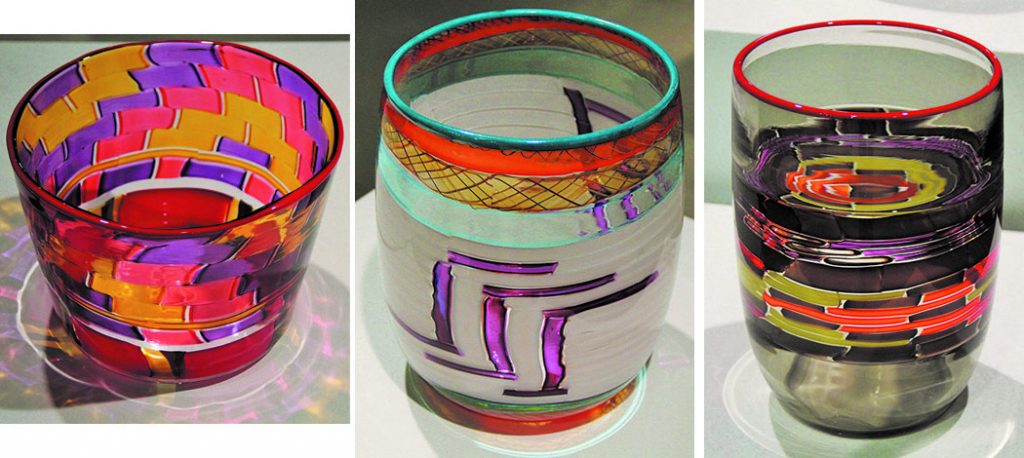
Ho-Wan-Ut Old Peter (Skokomish). Glass Basket. 2015.
Halisa Higheagle (Chehalis). Glass Basket. 2015.
Wa x WupKaya Jack-lyn Smith (Skokomish). Salmon Gill Design Glass Basket. 2015. Glass.
*Made during a workshop with hot shop lead artist, Dan Friday (Lummi), as a partnership between the Museum of Glass and the Longhouse.
“This exhibition reflects the [twenty-five years] of building relationships with artists locally, regionally, nationally and internationally,” stated exhibition co-curator Erin Genia. “Each of the artists you see here in the show has in some way worked with the Longhouse through one of our programs. Native artists are using so many different methods for expressing themselves and we really wanted to display as many of those methods as possible. The result is we have close to ninety beautiful pieces of art, treasures really, that make up this exhibition.”
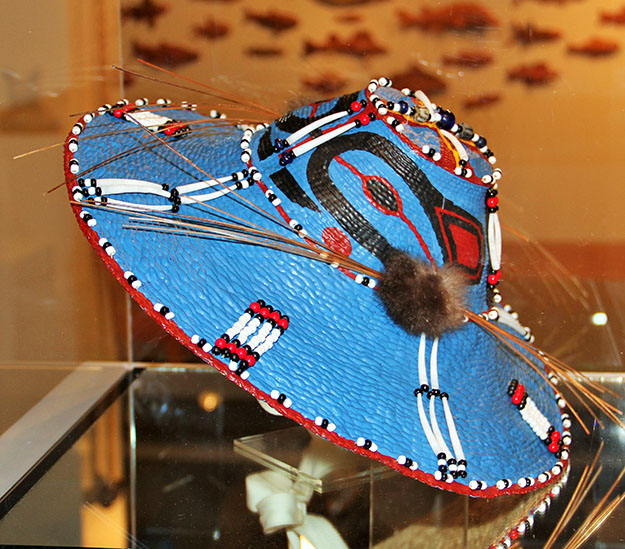
The subjects and techniques exhibited by the Longhouse artists draw from a diverse range of stylistic traditions, which arise from cultural teachings, ancestral lineages, and each artist’s unique experience as Indigenous peoples. Works on display include paintings, drums, carvings, beadwork, photography, baskets, and jewelry.
Glass vessels created using basket designs demonstrate the way traditional design can beautifully translate into new media. Other sculptural forms created in clay, bronze and wood, alongside two-dimensional prints, paintings and drawing spotlight the mastery of mediums that Longhouse artists are fluent in.
“As a curator of this exhibition it’s such an awe-inspiring experience to hear from the artists themselves as to the perspective and inspiration behind their artwork,” added fellow co-curator Linly Logan. “We have artists who are very traditional and roots oriented; artists who use the natural resources around them to showcase their creativeness.
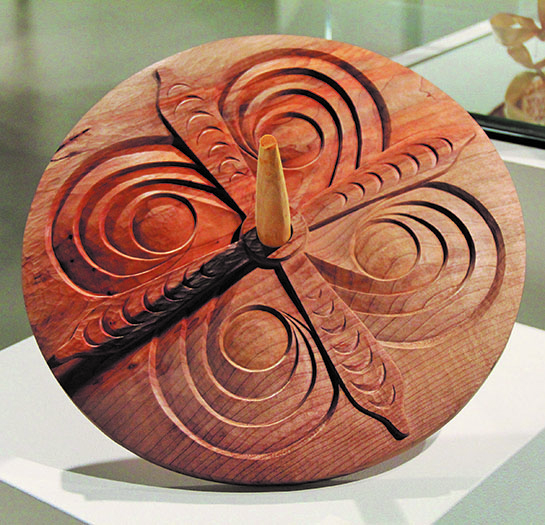
“As Native and Indigenous people we’ve always used the resources around us,” he continued. “In a contemporary lifestyle in nature, we’ve continued to use the resources around us which now include materials other than natural materials. We’ve come full circle in our intent to build upon the past and vision into the future creatively and intellectually as Indigenous people.”
The House of Welcome graciously allowed Tulalip News staff a private tour of the exhibition so that we could share a glimpse of the amazingly creative and exceptional Native art with our local community. These artists are luminaries of their cultures, lighting the pathway back into the far reaches of history, and leading the way into the future with their creative vision.